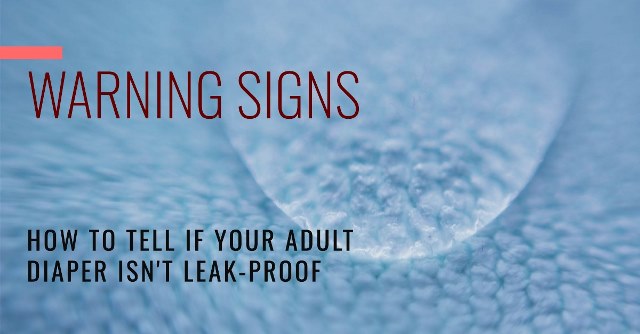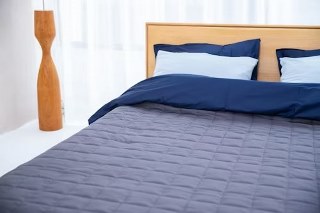For many older adults and those experiencing incontinence, finding the correct adult diapers is crucial to maintaining independence and comfort. But how can you be sure your diaper indeed provides leak-proof protection?
What signs should you watch out for that could indicate your diaper isn’t living up to its promise of keeping you dry? And do you want to risk discomforting leaks ruining your day?
Here are some key warning signs to watch out for that could indicate your current diaper choice may not be living up to its leak-proof promise.
Warning Signs of a Leak-Prone Diaper

Frequent leakage incidents are among the most obvious signs that your current diaper may not be living up to its leak-proof promise. However, leaks don’t always manifest in the same way. Let’s take a closer look at some common warning signs to watch out for:
1. Visible Wetness or Dampness
One clear sign is visible moisture, where the diaper should keep you dry. Dampness at leg openings or waist after changes, or darkened areas soaking through, means barriers aren’t containing liquid as intended. Knowing how to change an adult diaper lets you spot these leakage signs – carefully unfold during changes to check for damp or dark spots, confirming containment failed beyond minor issues. Proper changes help identify leaks early.
2. Odor Issues
No one wants to deal with unpleasant odors throughout the day. However, strong odors released during or after changing adult pampers could mean leaks are worse than anticipated. That’s because contained leaks produce a slight smell, but liquids dispersed beyond inner layers spread bacteria, producing ammonia and other unpleasant smells more readily. Persistent odors may signify your current diaper just isn’t blocking leaks effectively.
3. Skin Irritation or Rashes
Continual dampness against sensitive areas, even from minor seepage, can lead to irritation over time. This is why carefully considering your choice of adult diaper brands is essential. If you notice redness, flaking, or rashes forming in leak-prone regions like thighs or bottom after multiple uses, poor sealing exposes skin unnecessarily. Given the risk of infection from recurring wetness, a new option with a tighter barrier may be worthwhile.
4. Poor Fit or Comfort
A diaper should feel snug but not constricting. Odd bulges or gaps could mean it isn’t molding to your unique shape. Moreover, pain or chafing from loose or tight areas is an early sign of fit issues worsening as movement contributes to leaks. Pay attention to discomfort cues and adjust sizing or style before problems escalate.
5. Tape or Fastener Issues
Adhesives holding multiple layers together are as vital as any other part. Yet peeling, cracking, or slipping tapes can silently compromise the barrier. Check for such defects each change – any flaws detected early mean preventively switching to intact products before failures arise.
6. Drips or Spots on Undergarments
One concerning sign is spots appearing on clothes after diaper changes. Even small leaks that do not touch the skin can migrate outward. Check underwear and pants for new dampness, drips, or residue post-changing as evidence that containment somewhere did not entirely prevent liquid transfer beyond the perimeter. Consistently finding clothing spots signals the current diaper risks public accidents, impacting confidence—choosing a diaper with barriers to avoid such unwanted transfers is essential.
How To Address Leak Issues
A thoughtful approach is critical to finding a practical solution when leaks occur. Here are the essential considerations:
1. High-Quality Products
When choosing between adult diaper brands, going with a quality name matters greatly. Reputable companies extensively research fabrics, adhesives, and core designs scientifically proven to block leaks. Their diapers undergo stringent testing to ensure consistent containment. Unlike inferior options using cheap substitutes, you can feel confident that a brand’s protection claims are substantiated.
2. Proper Fit
Diapers must form an excellent seal against the skin to do their job. Taking time to measure and select the diaper that is correctly sized according to the guidelines is critical. One that is too loose cannot hug contours needed to close entry points, nor will elastic adequate grip. Conversely, a tight diaper inhibits skin from breathing and risks chafing. Only a streamlined fit optimizes coverage.
3. Boost Absorbency with Bed Pads
Minor bed leaks may require extra nighttime protection. Absorbent bed pads inserted under sheets supplement diaper capacity. The pads, made with gels and fibers, absorb small leaks before they reach the sheets, boosting security without changing diapers. Bed pads also simplify cleanup if leaks do occur overnight.
4. Proper Hygiene through Proper Changing
Consistently practicing good hygiene, including timely diaper changes, is essential. Knowing how to change an adult diaper properly minimizes bacteria and irritants. It’s also necessary to clean skin thoroughly during changes and dry well between folds. Frequent cleaning and drying of key contact regions protect sensitive areas.
5. Consult Medical Experts
Dealing with ongoing leaks can significantly impact one’s quality of life. If lifestyle changes and hygiene routines fail to resolve the issue in the long term, a doctor’s visit provides invaluable next steps. Only medical experts can thoroughly examine the root causes through assessments. Their consultations look at all factors contributing to incontinence.
Based on examination findings, physicians can then recommend personalized treatment plans. These plans aim to manage leaks through customized solutions. This may include tailored therapies to address any medical issues discovered. When suitable, medical consultants also provide product guidance drawing on extensive experience.
Depending on needs, recommendations could involve premium protective solutions like depends on adult diapers, designed for leak protection and convenience. Seeing a specialist ensures determining the most holistic path forward for improved well-being.

Final Thoughts
Awareness of warning signs can help ensure the right type and fit of adult diapers for optimal leak protection. But how will you know if leaks are occurring too often? And what options exist if your usual brand isn’t keeping up? If worrying wetness escapes the diaper border regularly, it may be time to try another style, size, or brand with improved leakage barriers.
Consulting care providers can also reveal alternative solutions when needed. Ultimately, freedom from distressing leaks depends on discerning those cautionary signs and finding a diaper designed for proper containment. Feel free to experiment – what steps will give you complete confidence in your coverage?


